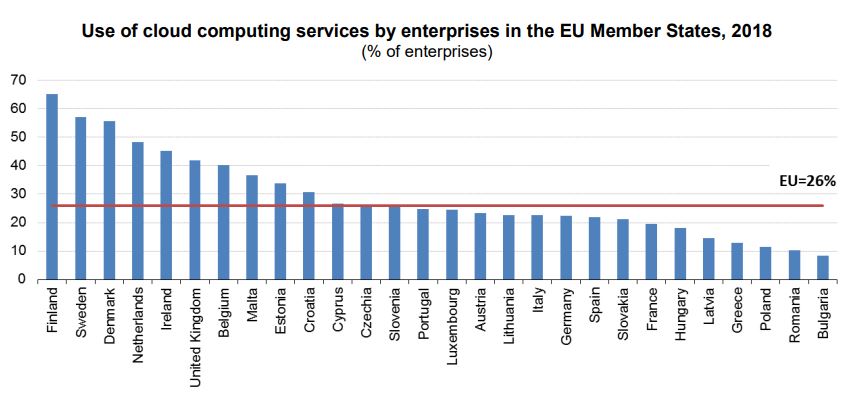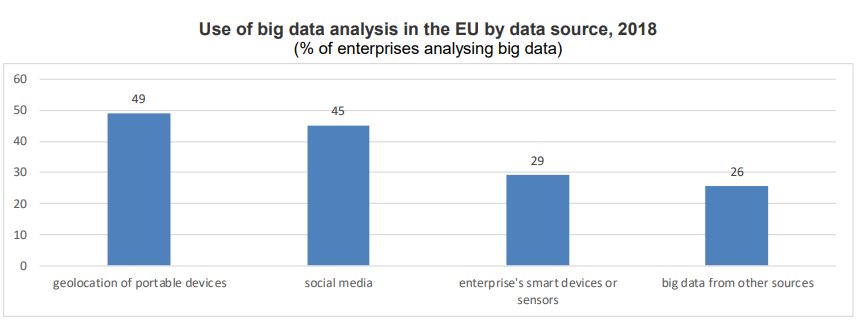In 2018, 26% of EU enterprises with at least 10 persons employed purchased cloud computing services. Cloud computing usage grew rapidly over the last few years, as in 2014 it stood at 19% and in 2016 at 21%. Large enterprises use cloud computing much more (56% of enterprises employing 250 persons or more) than small ones (23% of enterprises employing 10 to 49 persons). Over the last four years (between 2014 and 2018), the highest increase in cloud computing usage was observed in large enterprises (+21 percentage points), compared with +12pp in medium sized enterprises and +6pp in small enterprises.

Over half of enterprises used cloud computing services in Nordic EU Member States
Significant differences can be observed across countries in regards to cloud computing usage. Over half of enterprises in Finland (65%), Sweden (57%) and Denmark (56%) used cloud computing. At the opposite end of the scale, cloud computing services were used by 10% or fewer enterprises in Bulgaria (8%) and Romania (10%).
In 2018, enterprises used cloud computing mostly for e-mail (69% of enterprises that used cloud computing),closely followed by the storage of files in electronic form in a cloud (68%). Enterprises less frequently purchased computing power to run the enterprise’s own software (23%), or used CRM software applications over the cloud for managing information about customers (29%).

More than 1 in 10 EU enterprises analysed big data
In recent years, the quantity of digital data created, stored and processed in the world has grown exponentially. Each activity conducted online or by using information and communication technologies generates series of digital imprints which, given their volume, variety and velocity, are referred to as ‘big data’. In the EU, 12% of enterprises with at least 10 persons employed reported analysing big data. Such analyses are predominantly done by large(33%) and medium sized (19%) enterprises, and carried out by internal staff (8%) or by external service providers (5%).
Big data analysis most used in Malta, the Netherlands, Belgium and Ireland
Among EU Member States, the largest shares of enterprises analysing big data were observed in Malta (24%),the Netherlands (22%), Belgium and Ireland (both 20%). The smallest shares were noted in Cyprus (5%),Hungary and Austria (both 6%), Bulgaria and Italy (both 7%).
Mostly used data sources are geolocation of portable devices and data generated from social media
Enterprises that analysed big data used a variety of data sources. Almost half of all enterprises analysed geolocation data from the use of portable devices e.g. portable devices using mobile telephone networks, wireless connections or GPS (49%), followed by data generated from social media e.g. social networks (45%). Less than one third of enterprises analysed own big data from smart devices or sensors (29%) or data from other sources (26%).

4% of EU enterprises used 3D printing, with highest share in Finland, lowest in Cyprus and Latvia
In the EU, 4% of enterprises with at least 10 persons employed used 3D printing in 2018. In large enterprises,the share of 3D printer usage stood at 13% compared with 3% in small enterprises. The largest shares of enterprises using 3D printing in 2018 were observed in Finland (7%), Denmark, Malta,the United Kingdom and Belgium (all 6%). The smallest shares were reported by enterprises in Cyprusand Latvia (both 1%), followed by Estonia, Bulgaria, Greece, Hungary, Romania and Poland (all 2%).More than half of enterprises that used 3D printing used this technology for prototypes or models for internal use(57%). Less than one third used 3D printing for prototypes or models for sale (32%) or for goods to be usedin the enterprise’s production process (27%). Only 17% used 3D printing for goods other than prototypes or models to be sold.
Geographical information
The European Union (EU) includes Belgium, Bulgaria, Czechia, Denmark, Germany, Estonia, Ireland, Greece, Spain, France,Croatia, Italy, Cyprus, Latvia, Lithuania, Luxembourg, Hungary, Malta, the Netherlands, Austria, Poland, Portugal, Romania, Slovenia, Slovakia, Finland, Sweden and the United Kingdom.
Methods and definitions
Data presented in this News Release are based on the results of the 2018 European Union survey on ‘ICT usage and ecommercein enterprises’. This survey covered enterprises with at least 10 persons employed in manufacturing; electricity, gasand steam; water supply; construction; wholesale and retail trade, repair of motor vehicles and motorcycles; transportation andstorage; accommodation and food service activities; information and communication; real estate; professional, scientific andtechnical activities; administrative and support activities; repair of computers and communication equipment.
Results on big data analysis and use of 3D printing refer to the year 2017. United Kingdom: big data analysis not available.
Cloud computing refers to ICT services that are used over the internet to access software, computing power, storage capacity, etc. where the services have all of the following characteristics:
– are delivered from servers of service providers;- can be easily scaled up or down (e.g. number of users or change of storage capacity);
– can be used on-demand by the user, at least after the initial set up (without human interaction with the service provider);
– are paid for, either per user, by capacity used, or they are pre-paid.CRM refers to Customer Relationship Management software application for managing information about customers (as a cloud computing service).
Big data refers to data generated from activities that are carried out electronically and from machine-to-machine communications and can be characterized by:
– significant volume referring to vast amounts of data generated over time;
– variety referring to the different format of complex data, either structured or unstructured (e.g. text, video, images, voice, sensor data, activity logs, click streams, coordinates, etc.);
– velocity referring to the high speed at which data is generated, becomes available and changes over time.
Big data analysis refers to the use of techniques, technologies and software tools for analysing big data extracted fromenterprise’s own data sources or other data sources.
3D printing refers to the use of special printers either by the enterprise itself or the use of 3D printing services provided byother enterprises for the creation of three dimensional physical objects using digital technology.
Enterprises are classified in different categories according to the number of persons employed.
– small enterprises: 10 to 49 persons employed;
– medium sized enterprises: 50 to 249 persons employed;-
-large enterprises: 250 or more persons employed.
For more information visit Eurostat website section on digital economy and society statistics.
This information comes from an article issued by Eurostat, the statistical office of the European Union, andforms part of the results of a survey conducted in 2018 on ICT (Information and Communication Technologies) usage in enterprises.